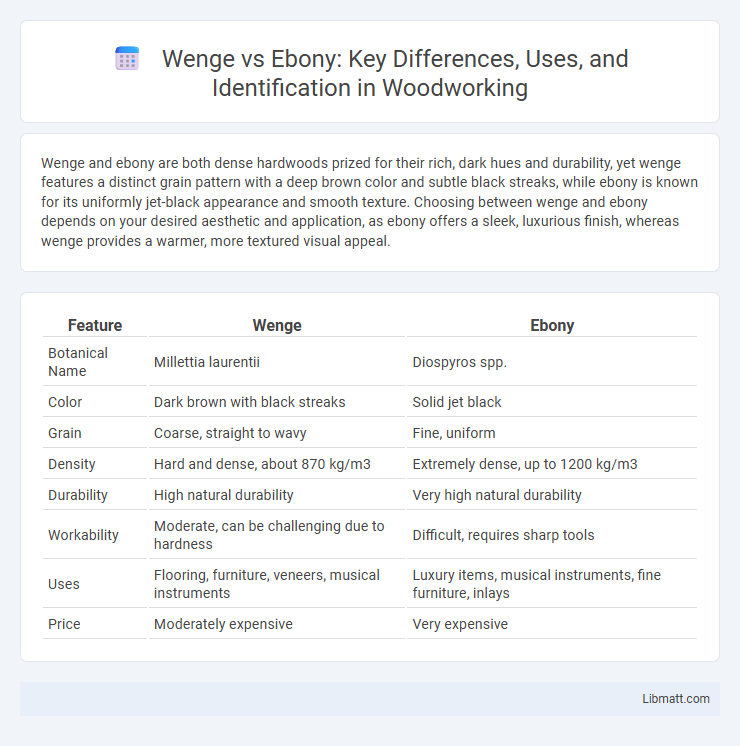Wenge and ebony are both dense hardwoods prized for their rich, dark hues and durability, yet wenge features a distinct grain pattern with a deep brown color and subtle black streaks, while ebony is known for its uniformly jet-black appearance and smooth texture. Choosing between wenge and ebony depends on your desired aesthetic and application, as ebony offers a sleek, luxurious finish, whereas wenge provides a warmer, more textured visual appeal.
Table of Comparison
| Feature | Wenge | Ebony |
|---|---|---|
| Botanical Name | Millettia laurentii | Diospyros spp. |
| Color | Dark brown with black streaks | Solid jet black |
| Grain | Coarse, straight to wavy | Fine, uniform |
| Density | Hard and dense, about 870 kg/m3 | Extremely dense, up to 1200 kg/m3 |
| Durability | High natural durability | Very high natural durability |
| Workability | Moderate, can be challenging due to hardness | Difficult, requires sharp tools |
| Uses | Flooring, furniture, veneers, musical instruments | Luxury items, musical instruments, fine furniture, inlays |
| Price | Moderately expensive | Very expensive |
Introduction to Wenge and Ebony
Wenge and ebony are prized hardwood species renowned for their deep, rich colors and durability, commonly used in high-end furniture and musical instruments. Wenge wood, sourced primarily from the African genus Millettia laurentii, displays a distinctive dark brown tone with subtle black streaks, providing a textured appearance. Ebony, hailing from the genus Diospyros and predominantly found in tropical regions, is characterized by its nearly jet-black color and fine, dense grain, making it one of the densest and most coveted hardwoods worldwide.
Botanical Origins and Species
Wenge and ebony both come from tropical hardwood trees but belong to different botanical families, with wenge derived from Millettia laurentii found mainly in Central Africa, while ebony comes from Diospyros species scattered across Asia and Africa. The dense, dark heartwood of ebony contrasts with the rich brown with black streaks typical of wenge, influenced by their distinct species characteristics. Understanding these botanical origins helps you select the right wood based on durability, color, and grain patterns for your woodworking or furniture needs.
Appearance and Color Differences
Wenge wood is characterized by its dark brown color with distinct black streaks, giving it a striped, textured appearance, while ebony wood is typically uniformly deep black or very dark brown, often with a smooth and glossy finish. The grain in wenge is coarse and open, contributing to its unique visual texture, whereas ebony generally features a fine, dense grain that appears more solid and consistent. These differences in appearance and color influence their use in luxury furniture, musical instruments, and decorative items.
Grain Pattern and Texture
Wenge wood features a distinctive, coarse grain pattern with a dark brown color and lighter streaks, offering a rough, dense texture that feels slightly uneven to the touch. Ebony typically exhibits a fine, uniform grain with a smooth, almost glassy texture and deep black coloration, sometimes with subtle brown or gray markings. The contrast in texture and grain pattern makes wenge ideal for bold, tactile furniture, while ebony suits sleek, polished decorative items and musical instruments.
Hardness and Durability Comparison
Wenge wood exhibits a Janka hardness rating of approximately 1630 lbf, making it significantly harder and more durable than ebony, which ranges around 2200 lbf but varies by species. Ebony's exceptionally dense, fine-grained structure provides superior resistance to wear, ideal for high-end furniture and musical instruments. While both woods boast remarkable durability, ebony's higher hardness contributes to increased resistance to dents and scratches, whereas Wenge offers better workability and dimensional stability over time.
Workability and Machinability
Wenge offers superior workability due to its coarse but consistent grain, making it easier to cut, shape, and sand compared to ebony, which is denser and more brittle, increasing the risk of chipping during machining. Ebony's hardness enhances durability but requires sharp tools and slower feed rates to avoid tool damage and achieve smooth finishes. When selecting wood for your project, consider that wenge's machinability allows for more intricate designs, while ebony excels in applications demanding high wear resistance.
Common Uses and Applications
Wenge and ebony woods are prized in high-end furniture making and musical instruments due to their density and rich coloration. Wenge is commonly used for flooring, cabinetry, and decorative veneers, offering a dark brown to black striped pattern that adds visual texture. Ebony's deep black hue and smooth finish make it a popular choice for piano keys, fingerboards, and luxury carvings, prized for both durability and aesthetic appeal.
Sustainability and Environmental Impact
Wenge and ebony woods differ significantly in sustainability and environmental impact due to their growth rates and harvesting practices. Wenge, primarily sourced from Central African rainforests, faces threats from overharvesting but benefits from some certification programs like FSC promoting responsible forestry. Ebony, known for its dense black heartwood, is highly endangered due to illegal logging and slow growth, making your choice of certified or reclaimed ebony crucial for minimizing environmental harm.
Price and Availability
Wenge wood typically commands a moderate price due to its abundant availability in Central Africa, making it a cost-effective choice for furniture and flooring. Ebony is significantly more expensive, attributed to its rarity and slow growth in tropical regions of Africa and Asia, driving high demand and limited supply. Both woods are sought after for luxury applications, but ebony's scarcity often results in longer lead times and higher overall costs compared to wenge.
Choosing Between Wenge and Ebony
Choosing between Wenge and Ebony depends on factors such as durability, appearance, and cost. Wenge offers a rich dark brown color with distinctive grain patterns, ideal for striking furniture and flooring, while Ebony is prized for its deep, jet-black hue and smooth texture, often reserved for high-end applications. Budget considerations also play a role, as Ebony tends to be more expensive due to its rarity compared to the more abundant Wenge.
Wenge vs ebony Infographic

 libmatt.com
libmatt.com